Characteristics of Dye-Sensitized Solar Cell Assembled from Modified Chitosan-Based Gel Polymer Electrolytes Incorporated with Potassium Iodide
Abstract
1. Introduction
2. Results and Discussion
2.1. Study of Impedance Spectroscopy
2.2. Dielectric Studies
2.3. J-V Characteristic of DSSC
3. Experimental
3.1. Modification of Chitosan to PhCh
3.2. Gel Polymer Electrolyte (GPE) Preparation
3.3. Characterization of GPEs
3.4. Fabrication of Dye-Sensitized Solar Cell (DSSC)
4. Conclusions
Author Contributions
Funding
Acknowledgments
Conflicts of Interest
References
- Winie, T.; Arof, A.K.; Thomas, S. Polymer Electrolytes: Characterization Techniques and Energy Applications. 2019. Available online: https://www.wiley.com/en-uz/Polymer+Electrolytes%3A+Characterization+Techniques+and+Energy+Applications-p-9783527342006 (accessed on 6 August 2020).
- Liu, Y.; Fang, J.; Liu, Y.; Lin, T. Progress in nanostructured photoanodes for dye-sensitized solar cells. Front. Mater. Sci. 2016, 10, 225–237. [Google Scholar] [CrossRef]
- Yusuf, S.N.F.; Aziz, M.F.; Hassan, H.C.; Bandara, T.M.W.J.; Mellander, B.E.; Careem, M.A.; Arof, A.K. Phthaloylchitosan-Based Gel Polymer Electrolytes for Efficient Dye-Sensitized Solar Cells. J. Chem. 2014, 2014, 1–8. [Google Scholar] [CrossRef]
- Yu, Z.; Vlachopoulos, N.; Gorlov, M.; Kloo, L. Liquid electrolytes for dye-sensitized solar cells. Dalton Trans. 2011, 40, 10289. [Google Scholar] [CrossRef] [PubMed]
- Kar, S.; Roy, J.K.; Leszczynski, J. In silico designing of power conversion efficient organic lead dyes for solar cells using todays innovative approaches to assure renewable energy for future. npj Comput. Mater. 2017, 3, 22. [Google Scholar] [CrossRef]
- Hagberg, D.P.; Yum, J.-H.; Lee, H.; De Angelis, F.; Marinado, T.; Karlsson, K.M.; Humphry-Baker, R.; Sun, L.; Hagfeldt, A.; Grätzel, M.; et al. Molecular Engineering of Organic Sensitizers for Dye-Sensitized Solar Cell Applications. J. Am. Chem. Soc. 2008, 130, 6259–6266. [Google Scholar] [CrossRef] [PubMed]
- Mohamad, A.A. Physical properties of quasi-solid-state polymer electrolytes for dye-sensitised solar cells: A characterisation review. Sol. Energy 2019, 190, 434–452. [Google Scholar] [CrossRef]
- Gong, J.; Liang, J.; Krishnan, S. Review on dye-sensitized solar cells (DSSCs): Fundamental concepts and novel materials. Renew. Sustain. Energy Rev. 2012, 16, 5848–5860. [Google Scholar] [CrossRef]
- Li, B.; Wang, L.; Kang, B.; Wang, P.; Qiu, Y. Review of recent progress in solid-state dye-sensitized solar cells. Sol. Energy Mater. Sol. Cells 2006, 90, 549–573. [Google Scholar] [CrossRef]
- Wu, J.; Lan, Z.; Hao, S.; Li, P.; Lin, J.; Huang, M.; Fang, L.; Huang, Y. Progress on the electrolytes for dye-sensitized solar cells. Pure Appl. Chem. 2008, 80, 2241–2258. [Google Scholar] [CrossRef]
- Mohamad, A.A. Absorbency and conductivity of quasi-solid-state polymer electrolytes for dye-sensitized solar cells: A characterization review. J. Power Sources 2016, 329, 57–71. [Google Scholar] [CrossRef]
- Bella, F. Polymer electrolytes and perovskites: Lights and shadows in photovoltaic devices. Electrochim. Acta 2015, 175, 151–161. [Google Scholar] [CrossRef]
- Kumara, N.; Lim, A.; Ming, L.C.; Petra, M.I.; Ekanayake, P. Recent progress and utilization of natural pigments in dye sensitized solar cells: A review. Renew. Sustain. Energy Rev. 2017, 78, 301–317. [Google Scholar] [CrossRef]
- Khan, M.Z.H.; Al-Mamun, M.; Halder, P.; Aziz, A. Performance improvement of modified dye-sensitized solar cells. Renew. Sustain. Energy Rev. 2017, 71, 602–617. [Google Scholar] [CrossRef]
- Yusuf, S.; Yusof, S.; Kufian, M.; Teo, L. Preparation and electrical characterization of polymer electrolytes: A review. Mater. Today Proc. 2019, 17, 446–458. [Google Scholar] [CrossRef]
- Sousa, A.M.; Sereno, A.M.; Hilliou, L.; Gonçalves, M.P. Biodegradable Agar Extracted from Gracilariavermiculophylla: Film Properties and Application to Edible Coating. 2010. Available online: https://www.scientific.net/MSF.636-637.739 (accessed on 6 August 2020).
- Hadi, J.M.; Aziz, S.B.; Nofal, M.; Hussein, S.A.; Hafiz, M.H.; Brza, M.A.; Abdulwahid, R.; Kadir, M.; Woo, H.J.; Hamsan, M.H. Electrical, Dielectric Property and Electrochemical Performances of Plasticized Silver Ion-Conducting Chitosan-Based Polymer Nanocomposites. Membranes 2020, 10, 151. [Google Scholar] [CrossRef] [PubMed]
- Nishimura, S.; Kohgo, O.; Kurita, K.; Kuzuhara, H. Chemospecific manipulations of a rigid polysaccharide: Syntheses of novel chitosan derivatives with excellent solubility in common organic solvents by regioselective chemical modifications. Macromolecules 1991, 24, 4745–4748. [Google Scholar] [CrossRef]
- Osman, Z.; Ibrahim, Z.; Arof, A. Conductivity enhancement due to ion dissociation in plasticized chitosan based polymer electrolytes. Carbohydr. Polym. 2001, 44, 167–173. [Google Scholar] [CrossRef]
- Yoksan, R.; Akashi, M.; Biramontri, S.; Chirachanchai, S. Hydrophobic Chain Conjugation at Hydroxyl Group onto γ-Ray Irradiated Chitosan. Biomacromolecules 2001, 2, 1038–1044. [Google Scholar] [CrossRef]
- Buraidah, M.H.; Teo, L.P.; Yusuf, S.N.F.; Noor, M.M.; Kufian, M.Z.; Careem, M.A.; Majid, S.R.; Taha, R.M.; Arof, A.K. TiO2/chitosan-NH4I (+ I2)-BMII-based dye-sensitized solar cells with anthocyanin dyes extracted from black rice and red cabbage. Int. J. Photoenergy 2011, 2011, 273683. [Google Scholar] [CrossRef]
- Yusuf, S.N.F.; Azzahari, A.D.; Yahya, R.; Majid, S.R.; Careem, M.A.; Arof, A.K. From crab shell to solar cell: A gel polymer electrolyte based on N-phthaloylchitosan and its application in dye-sensitized solar cells. Rsc Adv. 2016, 6, 27714–27724. [Google Scholar] [CrossRef]
- Grätzel, M. Solar Energy Conversion by Dye-Sensitized Photovoltaic Cells. Inorg. Chem. 2005, 44, 6841–6851. [Google Scholar] [CrossRef] [PubMed]
- Theerthagiri, J.; Senthil, R.A.; Buraidah, M.H.; Madhavan, J.; Arof, A.K. Effect of tetrabutylammonium iodide content on PVDF-PMMA polymer blend electrolytes for dye-sensitized solar cells. Ionics 2015, 21, 2889–2896. [Google Scholar] [CrossRef]
- Boschloo, G.; Hagfeldt, A. Characteristics of the Iodide/Triiodide Redox Mediator in Dye-Sensitized Solar Cells. Acc. Chem. Res. 2009, 42, 1819–1826. [Google Scholar] [CrossRef] [PubMed]
- Bella, F.; Vlachopoulos, N.; Nonomura, K.; Zakeeruddin, S.M.; Grätzel, M.; Gerbaldi, C.; Hagfeldt, A. Direct light-induced polymerization of cobalt-based redox shuttles: An ultrafast way towards stable dye-sensitized solar cells. Chem. Commun. 2015, 51, 16308–16311. [Google Scholar] [CrossRef]
- Cai, N.; Li, R.; Wang, Y.; Zhang, M.; Wang, P. Organic dye-sensitized solar cells with a cobalt redox couple: Influences of π-linker rigidification and dye–bath solvent selection. Energy Environ. Sci. 2013, 6, 139–147. [Google Scholar] [CrossRef]
- Yella, A.; Lee, H.-W.; Tsao, H.N.; Yi, C.; Chandiran, A.K.; Nazeeruddin, K.; Diau, E.W.-G.; Yeh, C.-Y.; Zakeeruddin, S.M.; Grätzel, M. Porphyrin-Sensitized Solar Cells with Cobalt (II/III)-Based Redox Electrolyte Exceed 12 Percent Efficiency. Science 2011, 334, 629–634. [Google Scholar] [CrossRef]
- Aziz, S.; Hamsan, M.H.; Kadir, M.F.Z.; Karim, W.; Abdullah, R.M. Development of Polymer Blend Electrolyte Membranes Based on Chitosan: Dextran with High Ion Transport Properties for EDLC Application. Int. J. Mol. Sci. 2019, 20, 3369. [Google Scholar] [CrossRef]
- Deka, M.; Kumar, A. Enhanced electrical and electrochemical properties of PMMA-clay nanocomposite gel polymer electrolytes. Electrochim. Acta 2010, 55, 1836–1842. [Google Scholar] [CrossRef]
- Aziz, S.; Abdulwahid, R.; Hamsan, M.H.; Brza, M.A.; Abdullah, R.M.; Kadir, M.; Muzakir, S.K. Structural, Impedance, and EDLC Characteristics of Proton Conducting Chitosan-Based Polymer Blend Electrolytes with High Electrochemical Stability. Molecules 2019, 24, 3508. [Google Scholar] [CrossRef]
- Hadi, J.M.; Aziz, S.B.; Mustafa, M.S.; Hamsan, M.H.; Abdulwahid, R.T.; Kadir, M.F.; Ghareeb, H.O. Role of nano-capacitor on dielectric constant enhancement in PEO:NH4SCNxCeO2 polymer nano-composites: Electrical and electrochemical properties. J. Mater. Res. Technol. 2020, 9, 9283–9294. [Google Scholar] [CrossRef]
- Hamsan, M.; Aziz, S.B.; Nofal, M.; Brza, M.; Abdulwahid, R.; Hadi, J.M.; Karim, W.O.; Kadir, M. Characteristics of EDLC device fabricated from plasticized chitosan:MgCl2 based polymer electrolyte. J. Mater. Res. Technol. 2020, 9, 10635–10646. [Google Scholar] [CrossRef]
- Baskaran, R.; Selvasekarapandian, S.; Hirankumar, G.; Bhuvaneswari, M. Vibrational, ac impedance and dielectric spectroscopic studies of poly(vinylacetate)-N,N-dimethylformamide-LiClO4 polymer gel electrolytes. J. Power Sources 2004, 134, 235–240. [Google Scholar] [CrossRef]
- Aziz, S.; Hamsan, M.H.; Abdullah, R.M.; Kadir, M.F.Z. A Promising Polymer Blend Electrolytes Based on Chitosan: Methyl Cellulose for EDLC Application with High Specific Capacitance and Energy Density. Molecules 2019, 24, 2503. [Google Scholar] [CrossRef] [PubMed]
- Osman, Z.; Zainol, N.; Samin, S.; Chong, W.; Isa, K.M.; Othman, L.; Supa’At, I.; Sonsudin, F. Electrochemical Impedance Spectroscopy Studies of Magnesium-Based Polymethylmethacrylate Gel Polymer Electroytes. Electrochim. Acta 2014, 131, 148–153. [Google Scholar] [CrossRef]
- Buraidah, M.; Shah, S.; Teo, L.; Chowdhury, F.I.; Careem, M.; Albinsson, I.; Mellander, B.E.; Arof, A.K. High efficient dye sensitized solar cells using phthaloylchitosan based gel polymer electrolytes. Electrochim. Acta 2017, 245, 846–853. [Google Scholar] [CrossRef]
- Zulkifli, A.M. Electrochemical Characteristics of Phthaloyl Chitosan Based Gel Polymer Electrolyte for Dye Sensitized Solar Cell Application. Int. J. Electrochem. Sci. 2020, 15, 7434–7447. [Google Scholar] [CrossRef]
- Aziz, M.F.; Buraidah, M.H.; Careem, M.A.; Arof, A.K. PVA based gel polymer electrolytes with mixed iodide salts (K+ I− and Bu4N+ I−) for dye-Sensitized solar cell application. Electrochim. Acta 2015, 182, 217–223. [Google Scholar] [CrossRef]
- Aziz, S.; Hassan, A.Q.; Mohammed, S.J.; Karim, W.; Kadir, M.; Tajuddin, H.A.; Chan, N.N.M.Y. Structural and Optical Characteristics of PVA:C-Dot Composites: Tuning the Absorption of Ultra Violet (UV) Region. Nanomaterials 2019, 9, 216. [Google Scholar] [CrossRef]
- Aziz, S.; Rasheed, M.A.; Abidin, Z.H.Z. Optical and Electrical Characteristics of Silver Ion Conducting Nanocomposite Solid Polymer Electrolytes Based on Chitosan. J. Electron. Mater. 2017, 46, 6119–6130. [Google Scholar] [CrossRef]
- Pursell, J.L.; Pursell, C.J. Host–Guest Inclusion Complexation of α-Cyclodextrin and Triiodide Examined Using UV-Vis Spectrophotometry. J. Phys. Chem. A 2016, 120, 2144–2149. [Google Scholar] [CrossRef]
- Licht, S.; Myung, N. Aqueous Polyiodide Spectroscopy and Equilibria and Its Effect on n-WSe2 Photoelectrochemistry. J. Electrochem. Soc. 2019, 142, 845–849. [Google Scholar] [CrossRef]
- Aziz, S.; Marif, R.B.; Brza, M.A.; Hamsan, M.H.; Kadir, M.F.Z. Employing of Trukhan Model to Estimate Ion Transport Parameters in PVA Based Solid Polymer Electrolyte. Polymers 2019, 11, 1694. [Google Scholar] [CrossRef] [PubMed]
- Nithya, S.; Selvasekarapandian, S.; Karthikeyan, S.; Inbavalli, D.; Sikkinthar, S.; Sanjeeviraja, C. AC impedance studies on proton-conducting PAN: NH4SCN polymer electrolytes. Ionics 2014, 20, 1391–1398. [Google Scholar] [CrossRef]
- Hadi, J.M. Electrochemical Impedance study of Proton Conducting Polymer Electrolytes based on PVC Doped with Thiocyanate and Plasticized with Glycerol. Int. J. Electrochem. Sci. 2020, 15, 4671–4683. [Google Scholar] [CrossRef]
- Mishra, R.; Rao, K. Electrical conductivity studies of poly(ethyleneoxide)-poly(vinylalcohol) blends. Solid State Ion. 1998, 106, 113–127. [Google Scholar] [CrossRef]
- Morsi, M.A.; El-Khodary, S.; Rajeh, A. Enhancement of the optical, thermal and electrical properties of PEO/PAM:Li polymer electrolyte films doped with Ag nanoparticles. Phys. B Condens. Matter 2018, 539, 88–96. [Google Scholar] [CrossRef]
- Kim, J.S. Electric Modulus Spectroscopy of Lithium Tetraborate (Li2B4O7) Single Crystal. J. Phys. Soc. Jpn. 2001, 70, 3129–3133. [Google Scholar] [CrossRef]
- Kumaran, V.S.; Ng, H.M.; Ramesh, S.; Ramesh, K.; Vengadaesvaran, B.; Numan, A. The conductivity and dielectric studies of solid polymer electrolytes based on poly (acrylamide-co-acrylic acid) doped with sodium iodide. Ionics 2018, 24, 1947–1953. [Google Scholar] [CrossRef]
- Ahad, N.; Saion, E.; Gharibshahi, E. Structural, Thermal, and Electrical Properties of PVA-Sodium Salicylate Solid Composite Polymer Electrolyte. J. Nanomater. 2012, 2012, 1–8. [Google Scholar] [CrossRef]
- Mustafa, M.S.; Ghareeb, H.O.; Aziz, S.; Brza, M.A.; Al-Zangana, S.; Hadi, J.M.; Kadir, M. Electrochemical Characteristics of Glycerolized PEO-Based Polymer Electrolytes. Membranes 2020, 10, 116. [Google Scholar] [CrossRef]
- Sima, C.; Grigoriu, C.; Antohe, S. Comparison of the dye-sensitized solar cells performances based on transparent conductive ITO and FTO. Thin Solid Film. 2010, 519, 595–597. [Google Scholar] [CrossRef]
- Arof, A.K.; Aziz, M.F.; Noor, M.; Careem, M.; Bandara, L.; Thotawatthage, C.; Rupasinghe, W.; Dissanayake, M. Efficiency enhancement by mixed cation effect in dye-sensitized solar cells with a PVdF based gel polymer electrolyte. Int. J. Hydrogen Energy 2014, 39, 2929–2935. [Google Scholar] [CrossRef]
- Saikia, D.; Han, C.; Chen-Yang, Y. Influence of polymer concentration and dyes on photovoltaic performance of dye-sensitized solar cell with P(VdF-HFP)-based gel polymer electrolyte. J. Power Sources 2008, 185, 570–576. [Google Scholar] [CrossRef]
- Shahan, S. Dye-Sensitized Solar Cells Using Phthaloylchitosan Based Gel Polymer Electrolyte Containing I¯/I3¯ Redox Species. Ph.D. Thesis, University of Malaya, Kuala Lumpur, Malaysia, 2016. [Google Scholar]
- Azmar, A.; Subban, R.; Winie, T. Improved long-term stability of dye-sensitized solar cell employing PMA/PVAc based gel polymer electrolyte. Opt. Mater. 2019, 96, 109349. [Google Scholar] [CrossRef]
- Chowdhury, F.I.; Buraidah, M.; Arof, A.; Mellander, B.E.; Noor, I. Impact of tetrabutylammonium, iodide and triiodide ions conductivity in polyacrylonitrile based electrolyte on DSSC performance. Sol. Energy 2020, 196, 379–388. [Google Scholar] [CrossRef]
- Yusuf, S.N.F.; Azzahari, A.D.; Selvanathan, V.; Yahya, R.; Careem, M.; Arof, A.K. Improvement of N-phthaloylchitosan based gel polymer electrolyte in dye-sensitized solar cells using a binary salt system. Carbohydr. Polym. 2017, 157, 938–944. [Google Scholar] [CrossRef]
- Chalkias, D.; Giannopoulos, D.; Kollia, E.; Petala, A.; Kostopoulos, V.; Papanicolaou, G.C. Preparation of polyvinylpyrrolidone-based polymer electrolytes and their application by in-situ gelation in dye-sensitized solar cells. Electrochim. Acta 2018, 271, 632–640. [Google Scholar] [CrossRef]
- Teo, L.; Tiong, T.; Buraidah, M.; Arof, A.K. Effect of lithium iodide on the performance of dye sensitized solar cells (DSSC) using poly(ethylene oxide) (PEO)/poly(vinyl alcohol) (PVA) based gel polymer electrolytes. Opt. Mater. 2018, 85, 531–537. [Google Scholar] [CrossRef]
- Dissanayake, M.; Thotawatthage, C.; Senadeera, G.; Bandara, T.; Jayasundera, W.; Mellander, B.-E. Efficiency enhancement by mixed cation effect in dye-sensitized solar cells with PAN based gel polymer electrolyte. J. Photochem. Photobiol. A Chem. 2012, 246, 29–35. [Google Scholar] [CrossRef]
- Kang, J.; Li, W.; Wang, X.; Lin, Y.; Li, X.; Xiao, X.; Fang, S. Gel polymer electrolytes based on a novel quaternary ammonium salt for dye-sensitized solar cells. J. Appl. Electrochem. 2004, 34, 301–304. [Google Scholar] [CrossRef]
- Noor, M.; Buraidah, M.; Careem, M.; Majid, S.; Arof, A.K. An optimized poly(vinylidene fluoride-hexafluoropropylene)-NaI gel polymer electrolyte and its application in natural dye sensitized solar cells. Electrochim. Acta 2014, 121, 159–167. [Google Scholar] [CrossRef]
- Aziz, M.F.; Noor, I.; Buraidah, M.; Careem, M.; Arof, A. PVA-based gel polymer electrolytes doped with (CH3)4NI/KI for application in dye-sensitized solar cells. In Proceedings of the (15th International Conference on Transparent Optical Networks ICTON 2013), Cartagena, Spain, 23–27 June 2013; pp. 1–4. [Google Scholar]
- Shah, S.; Buraidah, M.H.; Teo, L.P.; Careem, M.A.; Arof, A.K. Dye-sensitized solar cells with sequentially deposited anthocyanin and chlorophyll dye as sensitizers. Opt. Quantum Electron. 2016, 48, 219. [Google Scholar] [CrossRef]
- Arof, A.K.; Naeem, M.; Hameed, F.; Jayasundara, W.J.M.J.S.R.; Careem, M.A.; Teo, L.P.; Buraidah, M.H. Quasi solid state dye-sensitized solar cells based on polyvinyl alcohol (PVA) electrolytes containing I−/I3− redox couple. Opt. Quantum Electron. 2014, 46, 143–154. [Google Scholar] [CrossRef]
- Hassan, H.C.; Abidin, Z.H.Z.; Careem, M.A.; Arof, A.K. Chlorophyll as sensitizer in I−/I3−-based solar cells with quasi-solid-state electrolytes. High. Perform. Polym. 2014, 26, 647–652. [Google Scholar] [CrossRef]
- Ren, Y.; Zhang, Z.; Fang, S.; Yang, M.; Cai, S. Application of PEO based gel network polymer electrolytes in dye-sensitized photoelectrochemical cells. Sol. Energy Mater. Sol. Cells 2002, 71, 253–259. [Google Scholar] [CrossRef]
- Kuppu, S.V.; Jeyaraman, A.R.; Guruviah, P.K.; Thambusamy, S.; Velu, K.S.; Stalin, T. Preparation and characterizations of PMMA-PVDF based polymer composite electrolyte materials for dye sensitized solar cell. Curr. Appl. Phys. 2018, 18, 619–625. [Google Scholar] [CrossRef]
- Claude, H.Y.; Natalie, J.F. Geochemical applications of the simple salt approximation to the lattice energies of complex materials. Am. Mineral. 2005, 90, 488–496. [Google Scholar]
Sample Availability: Samples of the compounds are available from the authors. |
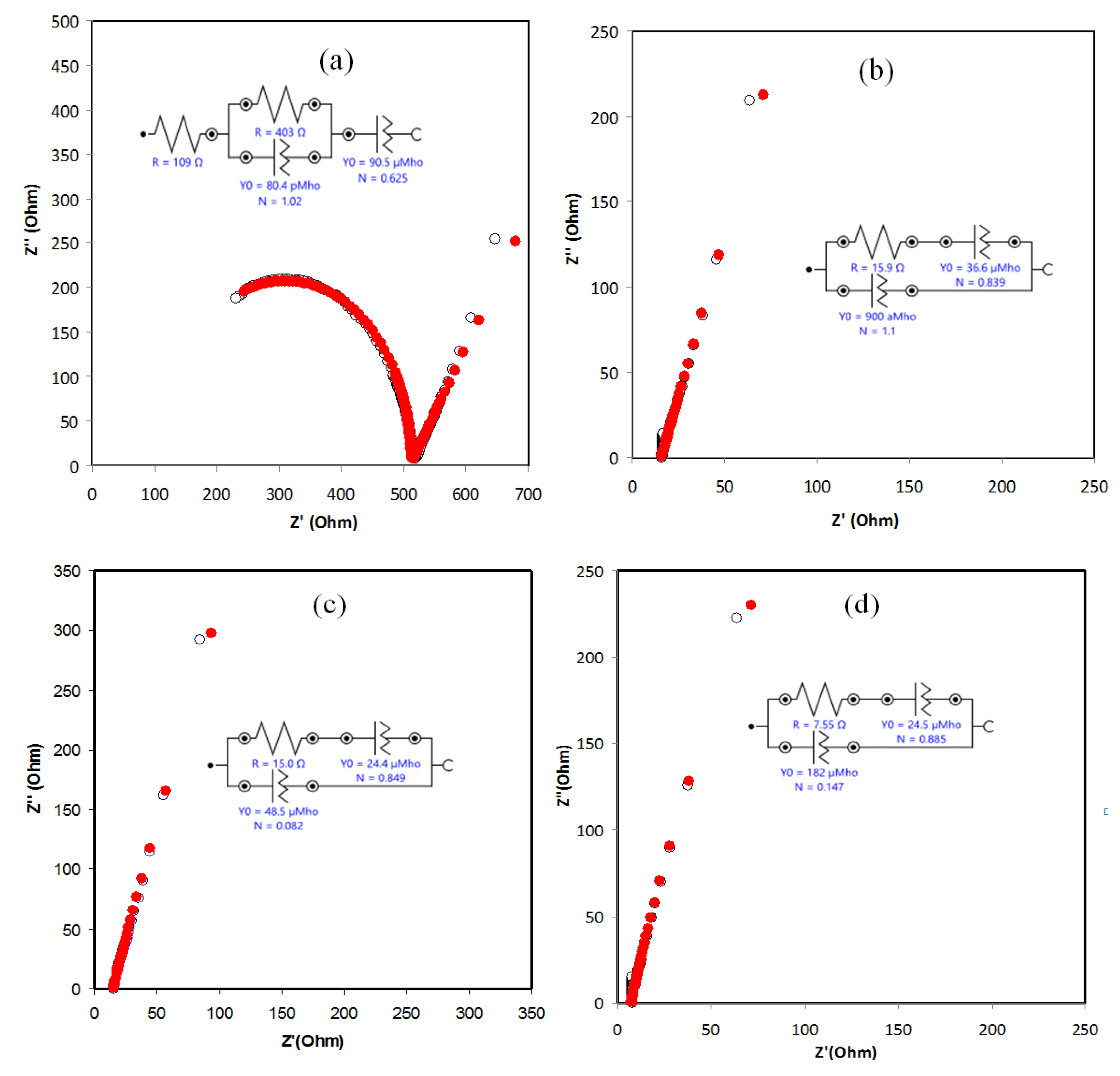
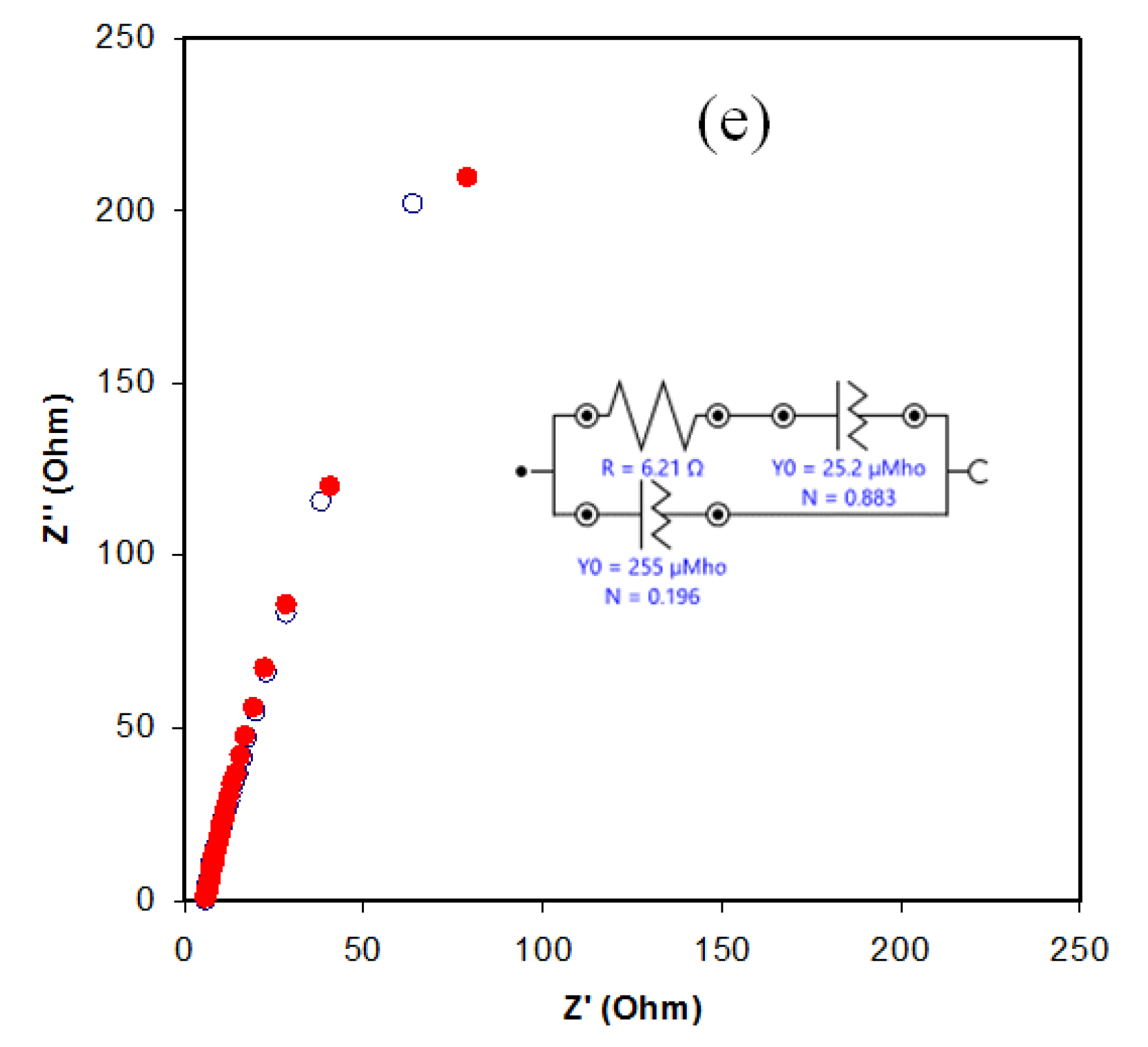
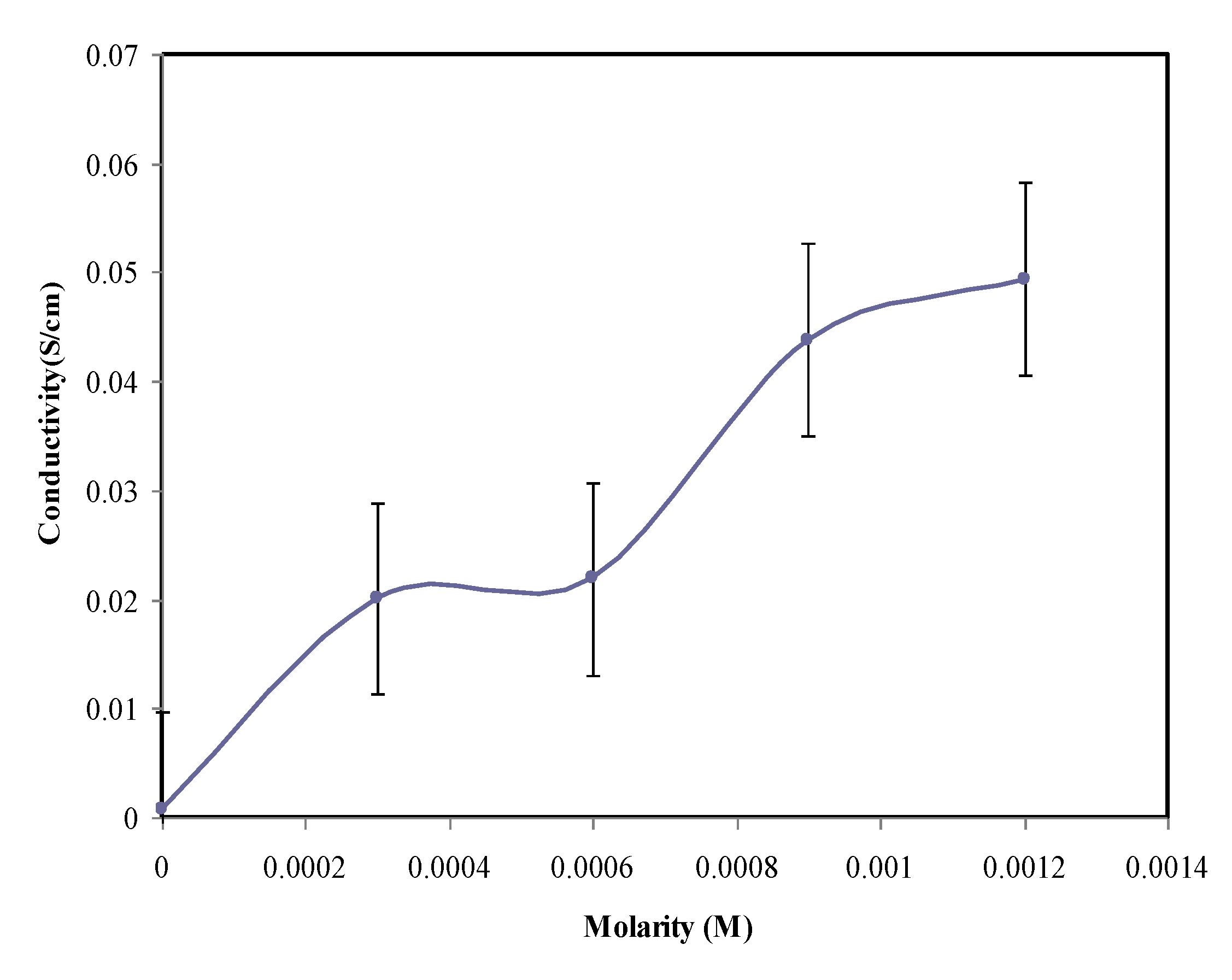
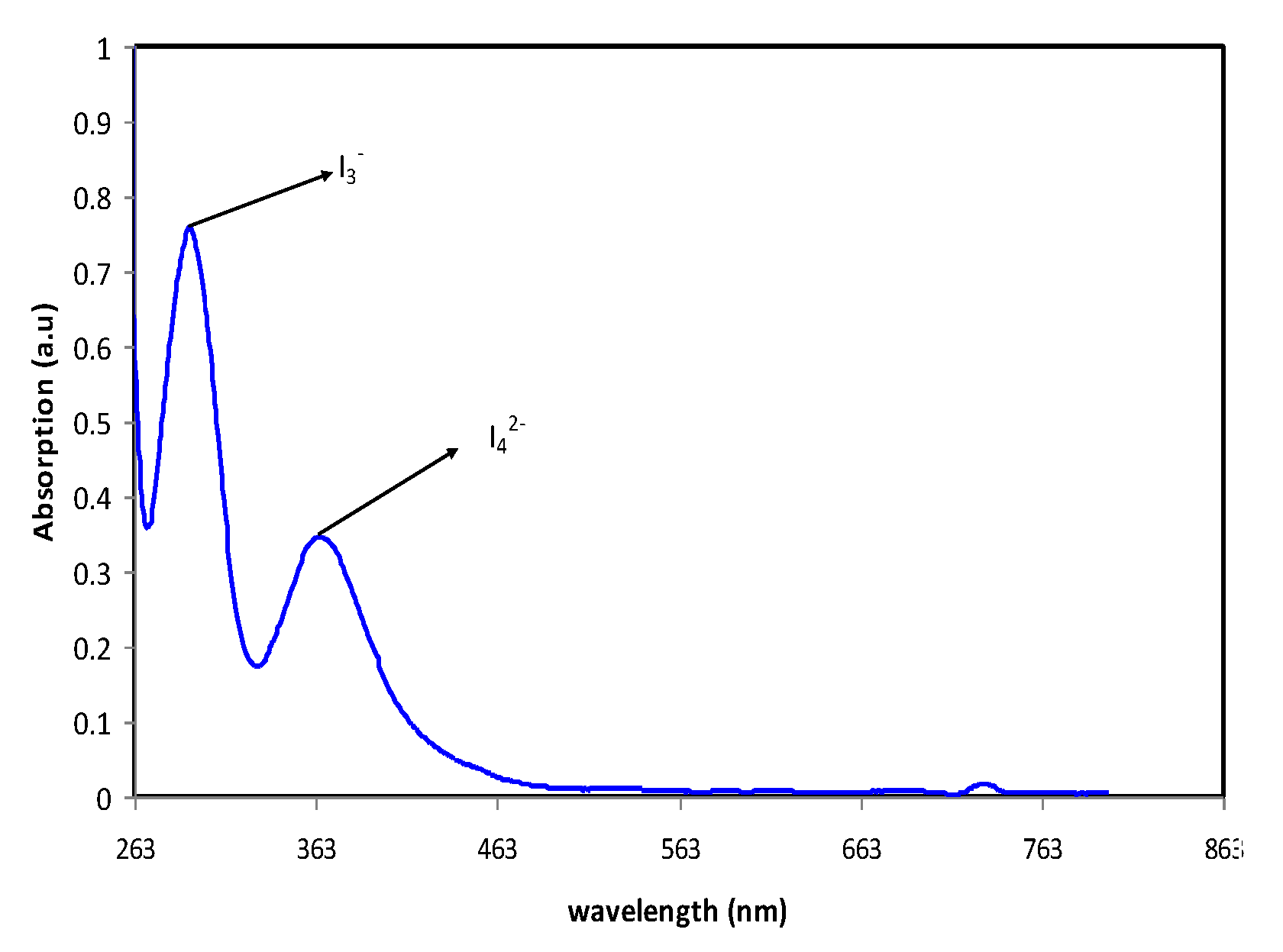
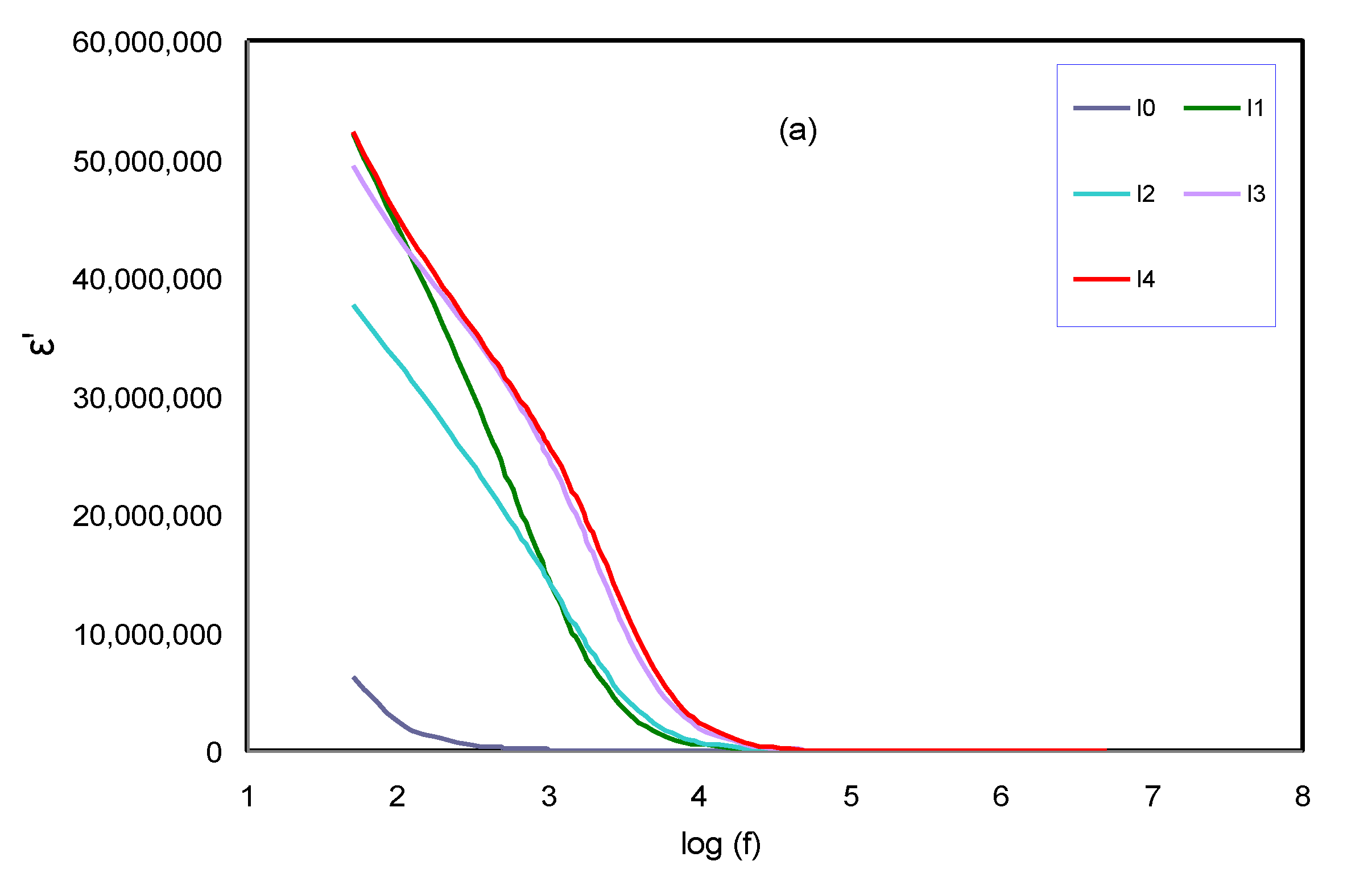

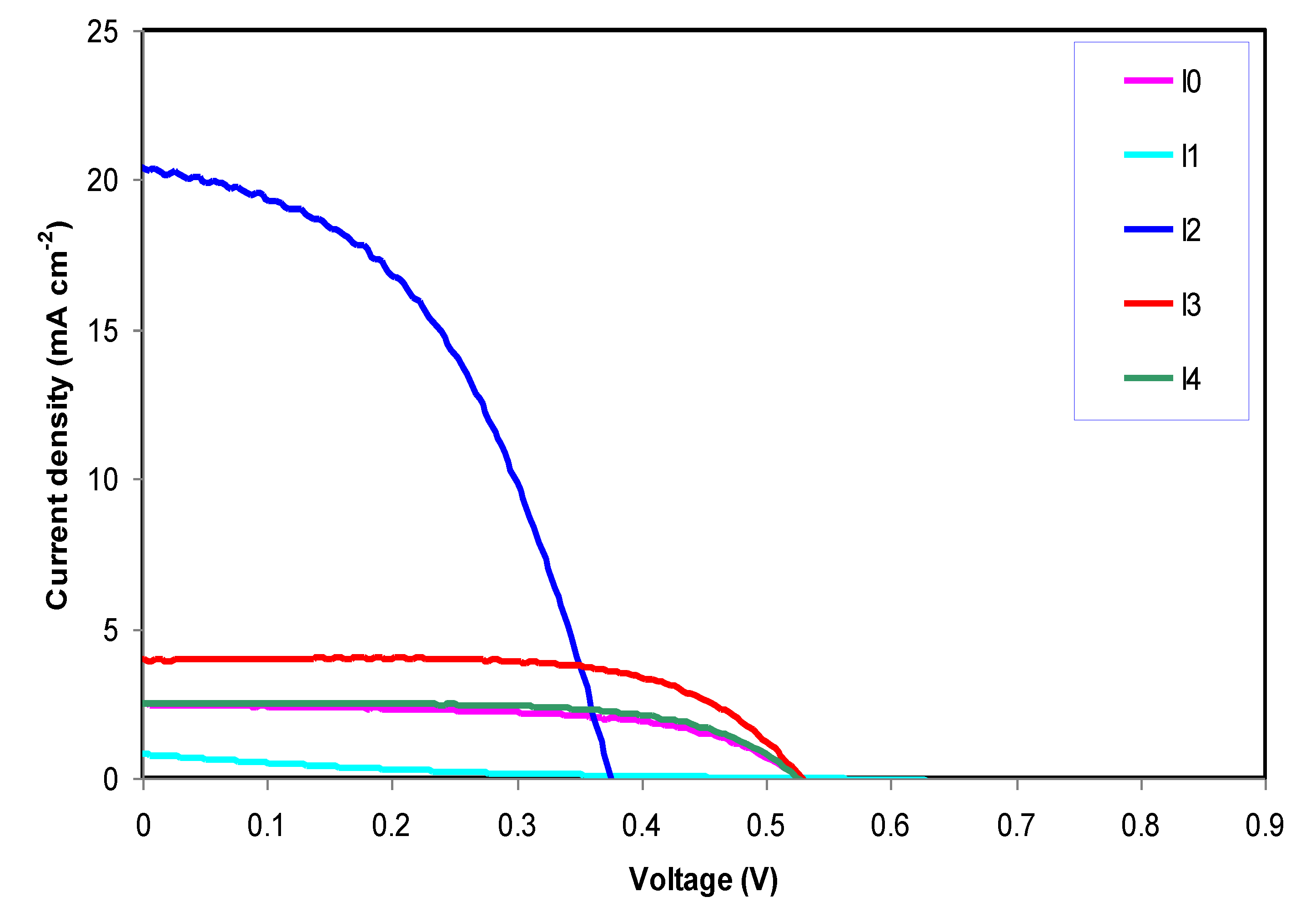
| Sample | Conductivity, S/cm |
|---|---|
| I0 | 8.213 × 10−4 |
| I1 | 2.01 × 10−2 |
| I2 | 2.19 × 10−2 |
| I3 | 4.38 × 10−2 |
| I4 | 4.94 × 10−2 |
| Sample Code | Ionic Conductivity σ (S/cm) | Dielectric Constant |
|---|---|---|
| I0 | 8.22 × 10−4 | 2.96 × 106 |
| I1 | 2.08 × 10−2 | 2.90 × 106 |
| I2 | 2.21 × 10−2 | 6.40 × 106 |
| I3 | 4.38 × 10−2 | 6.75 × 106 |
| I4 | 4.94 × 10−2 | 7.50 × 106 |
| Sample | Jsc | Voc (V) | FF | ƞ% |
|---|---|---|---|---|
| (mA cm−2) | ||||
| I0 | 2.46 | 0.51 | 0.14 | 0.76 |
| I1 | 0.78 | 0.48 | 0.47 | 0.06 |
| I2 | 20.33 | 0.37 | 0.65 | 3.57 |
| I3 | 3.96 | 0.52 | 0.64 | 1.35 |
| I4 | 2.51 | 0.52 | 0.59 | 0.84 |
| GPE Systems | Sensitizer | Efficiency (ƞ%) | References |
|---|---|---|---|
| PhCh:PEO:EC:DMF:TPAI/I2 | Anthocyanin | 0.56 | [67] |
| PVA:EC-PC:KI-TPAI/I2 | N3 | 3.27 | [68] |
| PAN:EC:PC:TPAI/I2 | Chlorophyll | 1.97 | [69] |
| PEO:EC-PC-DMC:NaI/I2 | N719 | 3.6 | [70] |
| PAN:EC:TPAI/I2 | N3 | 3.45 | [60] |
| PMMA:PVDF:KI:I2:EC/PC | N719 | 4 | [71] |
| PVDF:PMMA:EC: Imidazole:KI/I2 | N719 | 3.04 | [29] |
| PhCh:EC:DMF:KI/I2 | N3 | 3.57 | This work |
| Samples | PhCh (g) | DMF (g) | EC (g) | KI/mol | I2/mol |
|---|---|---|---|---|---|
| I0 | 0.2 | 0.6 | 0.6 | 0.0000 | 0.0000 |
| I1 | 0.2 | 0.6 | 0.6 | 0.0003 | 0.0003 |
| I2 | 0.2 | 0.6 | 0.6 | 0.0006 | 0.0006 |
| I3 | 0.2 | 0.6 | 0.6 | 0.0009 | 0.0009 |
| I4 | 0.2 | 0.6 | 0.6 | 0.0012 | 0.0012 |
© 2020 by the authors. Licensee MDPI, Basel, Switzerland. This article is an open access article distributed under the terms and conditions of the Creative Commons Attribution (CC BY) license (http://creativecommons.org/licenses/by/4.0/).
Share and Cite
Zulkifli, A.M.; Said, N.I.A.M.; Bakr Aziz, S.; Dannoun, E.M.A.; Hisham, S.; Shah, S.; Abu Bakar, A.; Zainal, Z.H.; Tajuddin, H.A.; Mohammed Hadi, J.; et al. Characteristics of Dye-Sensitized Solar Cell Assembled from Modified Chitosan-Based Gel Polymer Electrolytes Incorporated with Potassium Iodide. Molecules 2020, 25, 4115. https://doi.org/10.3390/molecules25184115
Zulkifli AM, Said NIAM, Bakr Aziz S, Dannoun EMA, Hisham S, Shah S, Abu Bakar A, Zainal ZH, Tajuddin HA, Mohammed Hadi J, et al. Characteristics of Dye-Sensitized Solar Cell Assembled from Modified Chitosan-Based Gel Polymer Electrolytes Incorporated with Potassium Iodide. Molecules. 2020; 25(18):4115. https://doi.org/10.3390/molecules25184115
Chicago/Turabian StyleZulkifli, Aimi Mahirah, Nur Izzah Aqilah Mat Said, Shujahadeen Bakr Aziz, Elham Mohammed Ali Dannoun, Shameer Hisham, Shahan Shah, Amnani Abu Bakar, Zul Hazrin Zainal, Hairul Anuar Tajuddin, Jihad Mohammed Hadi, and et al. 2020. "Characteristics of Dye-Sensitized Solar Cell Assembled from Modified Chitosan-Based Gel Polymer Electrolytes Incorporated with Potassium Iodide" Molecules 25, no. 18: 4115. https://doi.org/10.3390/molecules25184115
APA StyleZulkifli, A. M., Said, N. I. A. M., Bakr Aziz, S., Dannoun, E. M. A., Hisham, S., Shah, S., Abu Bakar, A., Zainal, Z. H., Tajuddin, H. A., Mohammed Hadi, J., Brza, M. A., Raza Saeed, S., & Amin, P. O. (2020). Characteristics of Dye-Sensitized Solar Cell Assembled from Modified Chitosan-Based Gel Polymer Electrolytes Incorporated with Potassium Iodide. Molecules, 25(18), 4115. https://doi.org/10.3390/molecules25184115








